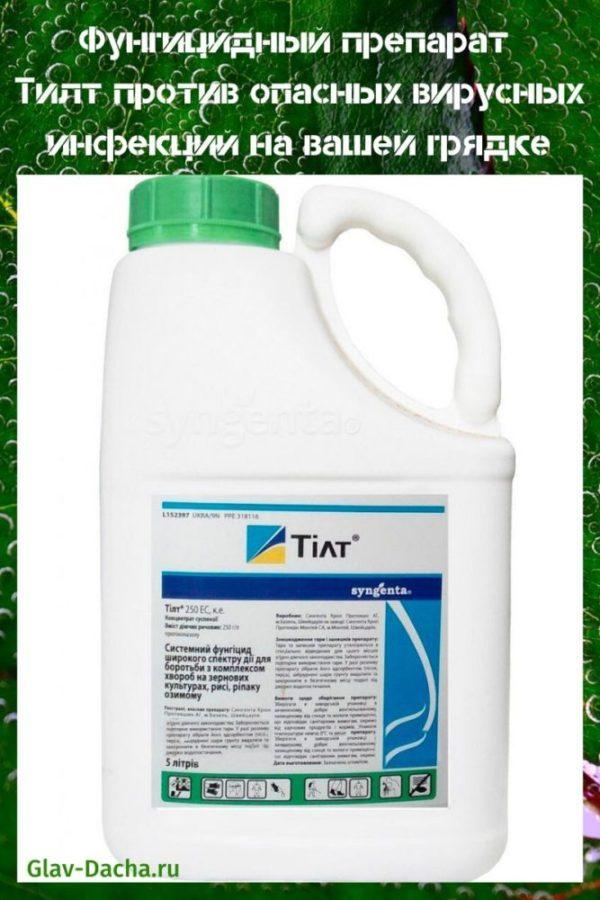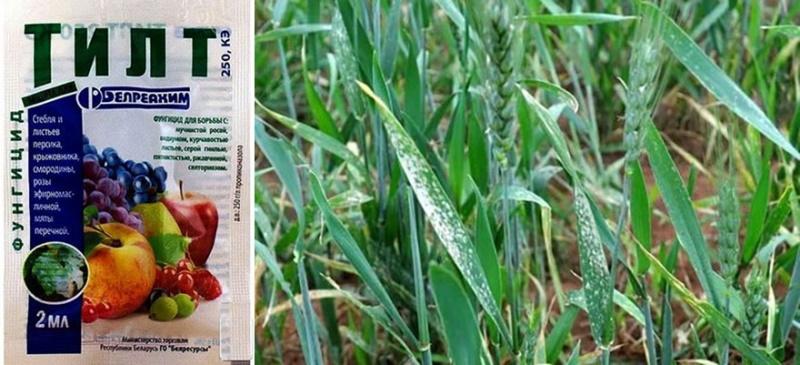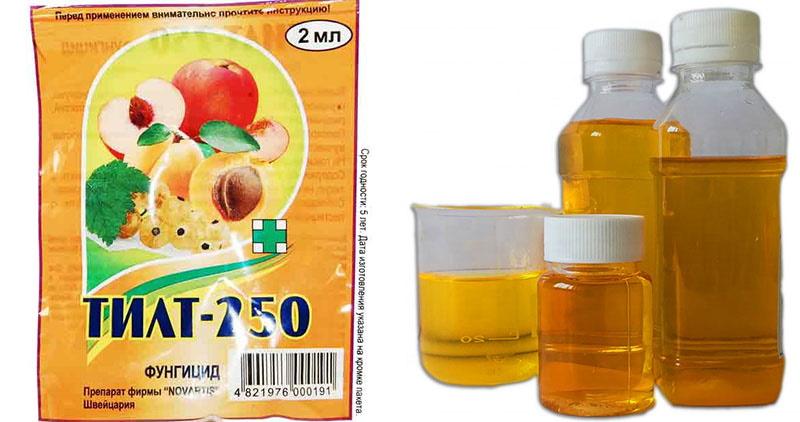Fungicidal drug Tilt against dangerous viral infections in your garden
 Fungal diseases mercilessly destroy the plantings of cereals and vegetables, fruit trees, shrubs and grapes. To protect plants from this invisible but powerful "enemy" will help the systemic drug Tilt, which deals with many types of dangerous fungal spores. To a greater extent, they affect stems and leaves. This leads to the cessation of the supply of nutrients to the main tissues of the culture. Since the fungicidal agent is prohibited for use in households, it is necessary to read its instructions and determine the exact dosage.
Fungal diseases mercilessly destroy the plantings of cereals and vegetables, fruit trees, shrubs and grapes. To protect plants from this invisible but powerful "enemy" will help the systemic drug Tilt, which deals with many types of dangerous fungal spores. To a greater extent, they affect stems and leaves. This leads to the cessation of the supply of nutrients to the main tissues of the culture. Since the fungicidal agent is prohibited for use in households, it is necessary to read its instructions and determine the exact dosage.
Tilt preparation in a microscope objective
 The chemical is produced in two forms: an emulsion in 5 liter canisters and in the form of 1 ml ampoules. The liquid is an amber or brown solution. Each liter of concentrate accounts for up to 250 g of the active ingredient - propiconazole. Upon contact with the culture, the active component begins to spread throughout all plant tissues in the first 40-50 minutes.
The chemical is produced in two forms: an emulsion in 5 liter canisters and in the form of 1 ml ampoules. The liquid is an amber or brown solution. Each liter of concentrate accounts for up to 250 g of the active ingredient - propiconazole. Upon contact with the culture, the active component begins to spread throughout all plant tissues in the first 40-50 minutes.
The drug Tilt accumulates in the next 2-3 hours, and after a day each part of the culture is completely protected by the fungicide.
The chemical compound retains its activity for 20-40 days, which is a waiting period. The effects of propiconazole are manifested in this way:
- destruction of the vegetative organs of pathogenic microorganisms;
- violation of the synthesis of ergosterol in the cell membranes of the pathogen;
- oppression of the sporulation process;
- destruction of newly formed fungi from spores within 2-5 days, which leads to the gradual elimination of the entire colony.

Each type of pathogen dies at different times. The causative agents of septoria are destructed on the 5th day, powdery mildew - by 4, rust - by 2.
Manufacturers recommend using the drug in the early stages of the development of infectious diseases, when the first signs appear. It has been observed that after dressing, crops grow even better. In addition, it enhances the process of photosynthesis and participates in the restoration of damaged plant tissues.
 Due to its unique properties, the fungicide is excellently combined with some means of protection of its pesticide group, including stimulants and growth regulators, as well as liquid fertilizers. However, before this, a test spraying is required to check the compatibility of the preparations.
Due to its unique properties, the fungicide is excellently combined with some means of protection of its pesticide group, including stimulants and growth regulators, as well as liquid fertilizers. However, before this, a test spraying is required to check the compatibility of the preparations.
Scope of Tilt 250
 The legislation of the Russian Federation permits the use of a systemic fungicide only when processing fields sown with grain crops (wheat, oats, barley, rye), sugar beet and rapeseed. Nevertheless, private farmers have successfully used the product to protect tomatoes, cucumbers, grapes, apples and cherries.
The legislation of the Russian Federation permits the use of a systemic fungicide only when processing fields sown with grain crops (wheat, oats, barley, rye), sugar beet and rapeseed. Nevertheless, private farmers have successfully used the product to protect tomatoes, cucumbers, grapes, apples and cherries.
The instructions for use of Tilt 250 indicate that the drug is highly effective for etching:
- gooseberry;
- black currant;
- essential oil roses;
- peach;
- peppermint.
 The cultivation of crops of clover, reygrass and fescue is practiced. In addition, the consumption rate per hectare of area is quite low. However, to obtain the desired result, spraying is carried out in the shortest possible time.
The cultivation of crops of clover, reygrass and fescue is practiced. In addition, the consumption rate per hectare of area is quite low. However, to obtain the desired result, spraying is carried out in the shortest possible time.
In most cases, propiconazole is excellent at fighting off pathogens of fungal infections such as:
- powdery mildew;
- rust;
- curly leaves;
- spotting;
- oidium;
- gray rot;
- seltoriosis (white spot).

Long-term studies have shown that a weak fungicide solution allows you to cope with oidium grapes and moniliosis of fruit trees.
The drug is introduced not only for medicinal but also prophylactic purposes. In the latter version, the dosage of the concentrate and the rate of consumption of the working fluid are almost halved. For garden crops, the safest dose is calculated so as not to harm the plants.
Application features
 The working solution is prepared according to the standard scheme. The required dosage is diluted in a small amount of liquid. It is worth remembering that the concentrate is poorly soluble in water, so the emulsion should be thoroughly mixed. In a calm state, sediment formation cannot be avoided.
The working solution is prepared according to the standard scheme. The required dosage is diluted in a small amount of liquid. It is worth remembering that the concentrate is poorly soluble in water, so the emulsion should be thoroughly mixed. In a calm state, sediment formation cannot be avoided.
The dose is calculated according to this principle:
- for preventive purposes: 0.2-0.3 ml per 1 liter of water;
- for treatment: 0.4-0.5 ml / l;
- prevention: 2-3 ml / 10 l;
- therapy - 4 ml / 10 l.
 The last two recommendations apply to the processing of large areas. Spring crops are sprayed 30 days after sowing, and winter wheat one month after the first shoots. The procedure is repeated only when serious foci of infectious diseases appear.
The last two recommendations apply to the processing of large areas. Spring crops are sprayed 30 days after sowing, and winter wheat one month after the first shoots. The procedure is repeated only when serious foci of infectious diseases appear.
The tomato title is applied 40 days before harvest. This is a significant disadvantage of the fungicide.
 The flow rate of the working fluid in all cases is 200-400 l / ha, and that of the pure concentrate is 0.8-1 l / ha. These indicators are calculated depending on the degree of planting damage and the type of causative agent of the fungal disease.
The flow rate of the working fluid in all cases is 200-400 l / ha, and that of the pure concentrate is 0.8-1 l / ha. These indicators are calculated depending on the degree of planting damage and the type of causative agent of the fungal disease.
Several important factors are taken into account when planning an event.:
- temperature within + 10 ... + 25˚С;
- wind speed no more than 5 m / s;
- relative humidity up to 50-60%;
- morning or evening time.
 A weak Titl 250 solution for grapes is prepared according to the scheme intended for prevention. One bush usually accounts for up to 1 liter of solution. Spraying of all types of crops should be abundant, but as uniform as possible. Cucumbers and gooseberries pickle quickly enough. In this case, the spray is used in such a way as to create a cloud, not a spray.
A weak Titl 250 solution for grapes is prepared according to the scheme intended for prevention. One bush usually accounts for up to 1 liter of solution. Spraying of all types of crops should be abundant, but as uniform as possible. Cucumbers and gooseberries pickle quickly enough. In this case, the spray is used in such a way as to create a cloud, not a spray.
Precaution will not be superfluous
 Since the fungicide is very strong, overdosing often leads to the death of garden crops. In addition, manufacturers prohibit re-treatment with Tilt. In case of a very strong infection of the planting, another agent from this group of pesticides is used. Although several chemicals can be used together, propiconazole is never mixed with nitrogenous substances and alkalis.
Since the fungicide is very strong, overdosing often leads to the death of garden crops. In addition, manufacturers prohibit re-treatment with Tilt. In case of a very strong infection of the planting, another agent from this group of pesticides is used. Although several chemicals can be used together, propiconazole is never mixed with nitrogenous substances and alkalis.
Spraying is carried out only with the use of personal protective equipment. Otherwise, the solution leaves chemical burns on the skin and causes bouts of severe coughing.
The shelf life of the drug is 3 years at a temperature of -10 ... + 35˚С in a dry and dark place. After opening, it decreases to 2 years, as it loses its properties.